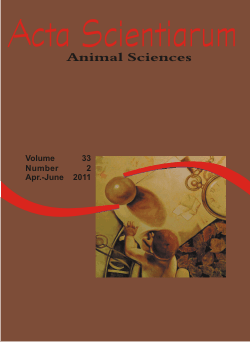<b>Assessment of arginine diet on the immune response of broilers immunized against Gumboro disease</b> - doi: 10.4025/actascianimsci.v33i2.9738
Keywords:
amino acid, infectious bursal disease, immune system, antibody titers, cloacal bursa
Abstract
The study was conducted to evaluate the effect of supplemental Arginine (Arg) on the humoral immune response and development of lymphoid organs of broiler chickens vaccinated against Gumboro disease. Six hundred and forty broilers were reared in a complete randomized design with four treatments (1. Control, 2. Immunization, 3. Immunization and supplementation of L-Arg, and 4. Supplemental L-Arg.) and eight replications of 20 birds each. Birds in treatments 3 and 4 were vaccinated at 16 days against Gumboro disease (intermediate plus strain). Serum samples from birds at 14, 21, 28 and 35 days old were analyzed by ELISA for detection of antibody titers against Gumboro disease, and at these same ages, lymphoid organ weight was determined and the height of the primary folds of lymphoid tissue in the cloacal bursa was measured. There was no significant difference (p > 0.05) among treatments. Arg supplementation did not improve the immune response of broilers immunized against Gumboro Disease. The lack of response to immunization may be attributed to the low virulence of the vaccine strain used and the presence of environmental virus.Downloads
Download data is not yet available.
Published
2011-04-28
How to Cite
Fernandes, J. I. M., Rosa, D. D., Ribeiro, M. V., Lima, E. T. de, & Fernandes, N. L. M. (2011). <b>Assessment of arginine diet on the immune response of broilers immunized against Gumboro disease</b> - doi: 10.4025/actascianimsci.v33i2.9738. Acta Scientiarum. Animal Sciences, 33(2), 151-155. https://doi.org/10.4025/actascianimsci.v33i2.9738
Issue
Section
Nonruminant Nutrition
DECLARATION OF ORIGINALITY AND COPYRIGHTS
- I Declare that current article is original and has not been submitted for publication, in part or in whole, to any other national or international journal.
The copyrights belong exclusively to the authors. Published content is licensed under Creative Commons Attribution 4.0 (CC BY 4.0) guidelines, which allows sharing (copy and distribution of the material in any medium or format) and adaptation (remix, transform, and build upon the material) for any purpose, even commercially, under the terms of attribution.
Read this link for further information on how to use CC BY 4.0 properly.
0.9
2019CiteScore
29th percentile
Powered by 








































